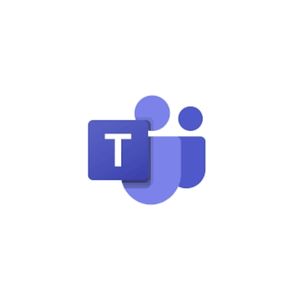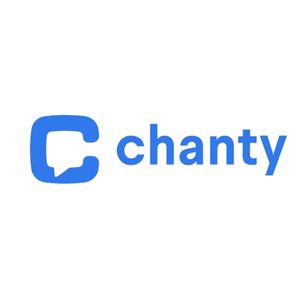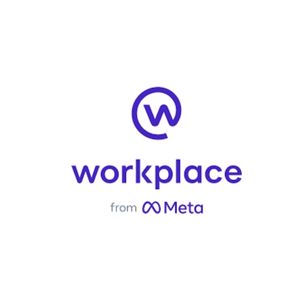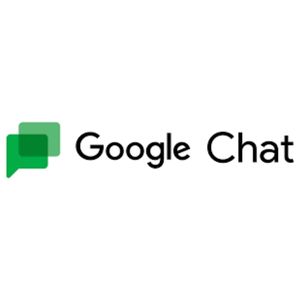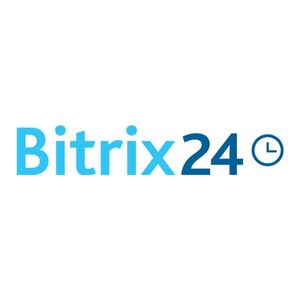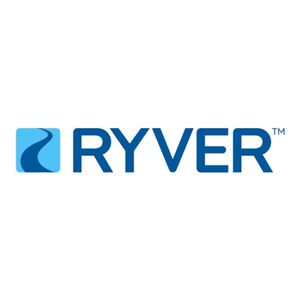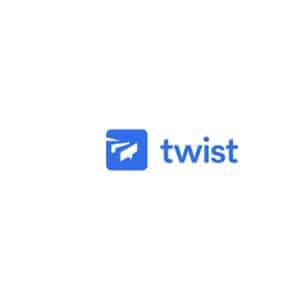Virtual communication is more important than ever and allows teams to connect from anywhere in the world.
Slack remains a popular option, but it has some drawbacks that make it less than ideal for some people.
If Slack doesn’t work for your team, consider Microsoft Teams as a viable alternative.
It’s a powerful platform that allows teams to connect virtually and even share documents.
Many workplaces love Microsoft teams as a method of communication and collaboration.
Whatever your team needs, one of these Slack alternatives is sure to fit the bill.
- Best Slack Alternatives (Overview)
- The Best Slack Alternative at a Glance
- An Overview of Slack
- Best Slack Alternatives: Our Top 3 Options [Ranked & Reviewed]
- Best Free Slack Options
- Notable Mentions: Other Alternatives to Slack
- Even More Options To Check Out
- Other Alternative Roundups (Similar to Slack)
- Frequently Asked Questions
- Wrapping Up
Best Slack Alternatives (Overview)
We’ve included an overview of our top picks below. For detailed information on each pick, scroll down.
- Microsoft Teams: Our Pick
- Chanty: Runner-Up
- Facebook Workplace Groups: Budget Pick
- Google Chat
- Fleep
- Bitrix24
- RingCentral Glip
- Zulip
- Ryver
- Twist
- RocketChat
The Best Slack Alternative at a Glance
While Slack is a popular tool for team communication and collaboration, some viable alternatives can meet the needs of specific teams and budgets.
What is the Best Alternative to Slack?
The best slack alternative is Microsoft Teams.
The platform works for businesses and teams of all sizes to streamline communication for team projects and virtual meetings.
It’s easy to use and can even work through a web browser, making it convenient for participants to tune in from almost anywhere.
What is the Best Free Alternative to Slack?
Google Chat is the best free alternative to Slack.
Unlike its predecessors, Google Chat is a functional communication platform that works on almost any device, including mobile devices.
It is fast and intuitive for basic messaging needs.
An Overview of Slack
Before discussing slack alternatives, it helps to know a bit about Slack’s capabilities, benefits, and shortcomings.
What is Slack?
Slack is a communication hub that can supplement other tools for productivity that lack messaging functions.
You can use it on your desktop and phone to connect with other members of your organization through different chat channels.
Slack’s internal messaging system lets teams communicate quickly and efficiently.
Organizations can send out mass communications, create groups and teams, or initiate private discussions.
Where Does Slack Excel?
Slack does a lot of things well, including frequent updates with new or improved features.
It’s easy to use, even if you don’t have a lot of technical expertise.
There are many ways to customize the Slack experience.
You can change the alerts to only notify you about activity on certain channels.
This makes it easier for people with large teams to ignore distracting and irrelevant notifications.
Where Does Slack Fall Short?
This platform isn’t perfect, or there wouldn’t be a need to discuss Slack alternatives.
It can be pricey compared to other options, especially if you need more than an internal messaging system.
Additionally, the audio and video meeting features need some upgrades to improve the quality.
They also don’t have a simple file-sharing feature, as other platforms do.
Best Slack Alternatives: Our Top 3 Options [Ranked & Reviewed]
Three platforms stand out among all the Slack alternatives.
These applications offer similar features to Slack but have slightly different strengths and weaknesses.
1. Microsoft Teams: Our Pick
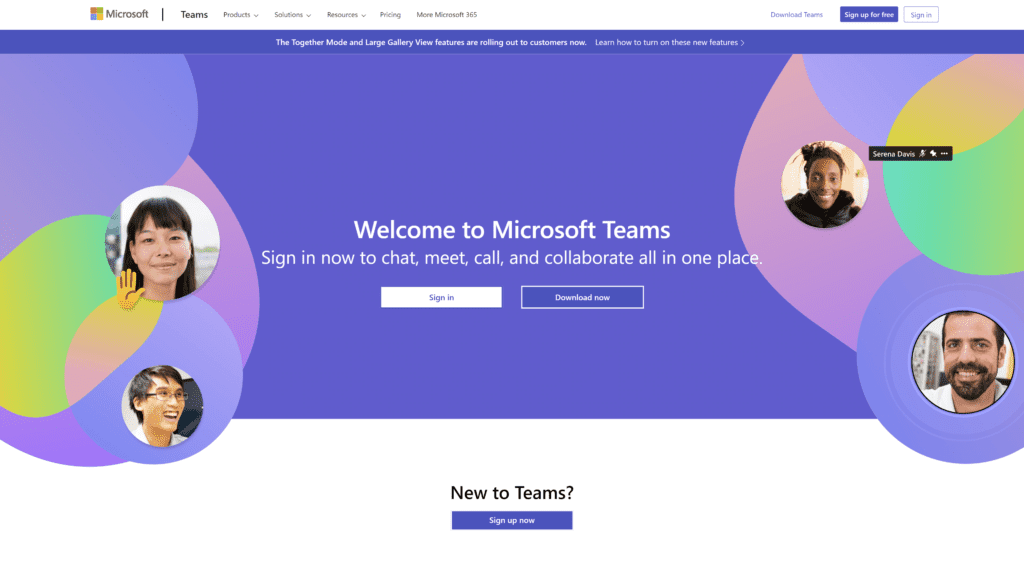
As one of the most versatile communication platforms available, Microsoft Teams works for personal, educational, and professional teams at every level.
This platform offers a range of communication options, including audio and video conferencing, chat, and synchronization with Outlook and Sharepoint.
You can also create teams and channels to break employees into groups for projects or team-building activities.
Microsoft Teams caters to small-group communications to streamline project management.
Individuals can even share documents so everyone can access and edit the same information.
Key Features of Microsoft Teams
- Choose between synchronous and asynchronous working options to accommodate team and individual needs
- Access multiple communication options ranging from live chat to video calls
- Create teams and groups to collaborate in different ways, like facilitating projects or breakout sessions
- Document sharing and editing features
- Connect to other Microsoft Suite programs, such as email, spreadsheets, and more
Slack vs Microsoft Teams: How They Compare
In the showdown of Slack vs Microsoft Teams, it comes down to preferences.
Slack is smooth and intuitive for open communication, but it lacks a few key features you get with Microsoft Teams, like seamless video conferencing and data security.
Slack might serve large teams better if you frequently communicate on a larger scale, whereas Microsoft Teams caters to small group and individual use.
Why is Microsoft Teams a Great Alternative to Slack?
Since it’s part of the Microsoft 365 Suite, Teams can easily access spreadsheets, documents, and presentations created within the suite.
You can access Microsoft Teams on most devices, including smartphones and tablets.
It can accommodate teams working asynchronously.
Microsoft Teams features a free plan along with three paid tiers to accommodate any budget.
Pros of Microsoft Teams:
- Multiple communication options: you can talk to your team in a multitude of ways, including audio calls, video conferencing, and live chat.
- Work in real-time or at your convenience: Teams’ convenient work options allow you to set your own schedule and keep up with your team.
- Robust security features: Two-step log-in, secure sharing, and file protection are just a few ways Microsoft Teams keeps your business safe.
Cons of Microsoft Teams:
- Only works with Microsoft applications: if a large majority of your team uses Google Docs, for example, file sharing might become difficult.
- Frequent updates can interrupt usage: Though they’re making their service better, there’s no telling when an update will pop up.
- Drains battery power on mobile devices: Microsoft Teams uses a lot of energy, so you may find your phone needing an extra charge during the work day.
Microsoft Teams Pricing:
- Essentials: $4 per month with an annual subscription
- Microsoft 365 Business Basic: $6 per month with an annual subscription
- Microsoft 365 Business Standard: $12.50 per month with an annual subscription
Can You Try Microsoft Teams for Free?
Yes. You can sign up for Microsoft Teams for free with no commitment, but you won’t receive all of the features that come with a paid subscription.
However, if you’re interested in a Business-level plan, you can start with a free trial of Microsoft Teams.
Conclusion: Should You Choose Microsoft Teams Over Slack?
Microsoft Teams is the top Slack alternative and a solid contender for organizations and individuals seeking a more efficient communication platform.
The document-sharing features make collaboration easier, as long as everyone involved can access Microsoft files.
It’s versatile with multiple communication methods to work for anyone, especially since it allows synchronous and asynchronous chats and messaging.
Though Microsoft Teams isn’t perfect, it’s one of the most versatile and comprehensive Slack alternatives available.
Technical Specifications
- Number of Users Allowed: 25,000
- File Storage Space: 1TB per team; can purchase additional 10GB of spaces
- Fully Supported Browsers: Microsoft Edge, Google Chrome
- Message Limit: unlimited, but messages can only be up to 28 KB
2. Chanty: Runner-Up

Chanty is another communication platform that allows teams to converse and collaborate.
The user-friendly interface includes some task management features with the ability to assign things to different users.
Teams can integrate several third-party apps, including Mailchimp, Dropbox, and Google Drive, making project completion easier.
Additionally, users can switch from chats to audio or video calls and send voice messages through the platform.
Key Features of Chanty
- Integrates with several third-party applications to streamline business processes
- Includes several task management features to keep projects moving
- Embraces artificial intelligence (AI) technology to improve other features, including chat functionality
- Can connect with other apps for greater functionality
- Allows control of group members to organize and create teams
Slack vs Chanty: How They Compare
While Slack focuses on communication, Chanty highlights productivity and task management.
Slack can easily distract users with too many notifications.
There is also not much support for facilitating projects beyond communication.
Chanty puts chats on the back burner without neglecting them.
Teams can still communicate with each other, but the overall platform focuses more on task creation and completion.
Why is Chanty a Great Alternative to Slack?
Chanty provides teams with task management features that Slack doesn’t offer.
It focuses on small to medium-sized organizations and those with at least some remote employees.
This platform is one of the more cost-effective options, especially with third-party integrations and workflow features that give you more flexibility and versatility.
Pros of Chanty:
- Useful task management tools: Chanty’s organizational methods allow you to control your workspace, chats, and document sharing.
- Multiple third-party integrations: unlike Microsoft Teams’ software-specific uses, you can use virtually any third-party business app with Chanty to keep everything in one place.
- Access to the entire chat history: some apps delete messages after a certain amount of time, but Chanty ensures that you’re able to see anything you need to, even messages from past conversations.
Cons of Chanty:
- Does not work with Linux or Chromebook: these laptops connect to other systems that prefer you to use their communication apps rather than an independent platform.
- Cannot host webinars: if you’re looking for a big conferencing feature, Chanty may not be the app for you.
- Severely limited free version: it can be difficult to tell whether or not Chanty will work for you based on the free trial.
Chanty Pricing:
The paid Business plan is $3 per user per month with unlimited members.
Can You Try Chanty for Free?
Yes, you can use Chanty for free as long as you have 10 or fewer users on the platform.
Note that the free version does not include access to the full range of features but it gives you an idea of what the platform offers.
Conclusion: Should You Choose Chanty Over Slack?
Chanty is the better choice for teams seeking task management capabilities and lower prices for their team software.
The platform is more cost-effective than Slack and Microsoft Teams, even with an upgrade to the paid version.
The ability to assign tasks and track progress is not available on Slack and can help teams struggling with productivity and efficiency.
Chanty is an ideal solution for smaller businesses or organizations, but the app’s limitations may be stifling for larger groups.
Still, if you’re looking for an inexpensive solution to productivity and communication woes, Chanty is a great pick.
Technical Specifications
- Number of Users Allowed: 10 free, $3 for each additional member
- File Storage Space: 20GB per team free, 20GB per member paid
- Fully Supported Browsers: Microsoft Edge, Google Chrome, Firefox, Safari
- Message Limit: unlimited
3. Facebook Workplace Groups: Budget Pick
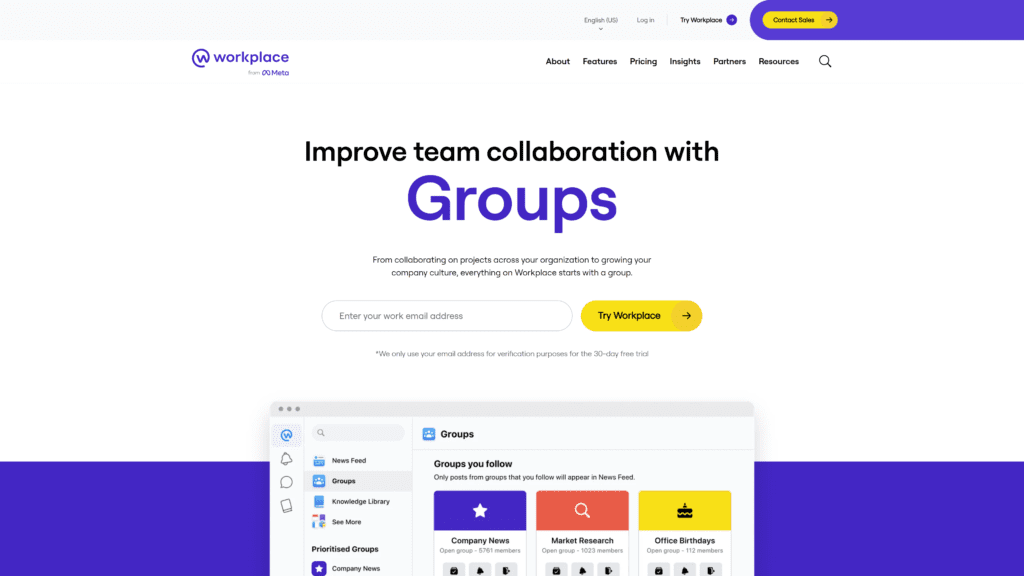
Facebook Workplace Groups offers a blend of productivity and communication in a familiar package.
Since Workplace Groups is so similar to the original Facebook app, it’s easy for most users to sign up, create a profile, and navigate the platform.
Plus, it’s possible to create groups, share information, and manage organizational events.
Key Features of Facebook Workplace
- The familiar interface means there’s no learning curve for most users
- Reinforce company culture with Q&A posts, event management tools, and achievement posts
- Share files among teams or with the whole organization
- Create and record live streams
- Small and large group options
Slack vs Facebook Workplace: How They Compare
Facebook Workplace has a friendlier price tag than Slack, but it’s also a familiar interface for those who use the social media version.
That said, Slack accepts more third-party integrations than Workplace, which may matter to some organizations.
Workplace might edge out Slack with the group chat options.
Both platforms can be distracting with notifications and easy accessibility, but they both have features to customize those settings.
Why is Facebook Workplace a Great Alternative to Slack?
Facebook Workplace is an affordable, familiar, and versatile option.
Though it’s all about chat and collaboration, Workplace offers some helpful tools that may improve productivity.
Workplace’s video capabilities allow teams to run live streams and record them for anyone who cannot attend.
It’s especially helpful for organizations with users in several time zones.
Pros of Facebook Workplace:
- Livestream and record videos to share internally: keep a record of any events and keep members who couldn’t make the call up-to-date.
- News feeds with AI technology: you can stay in touch with the latest news and trends without needing a second app.
- Integrates with popular third-party options, like Office 365: you can share documents without having to transfer them to a different app.
Cons of Facebook Workplace:
- No free version: after your 30-day free trial, you must pay to use Workplace, even if you don’t use all of the features.
- Customer support leaves something to be desired: if you experience issues, you may not be able to get a timely response.
- Just as distracting as the original Facebook: at its base, Facebook Workplace is a social media platform, and most people will see it as such.
Facebook Workplace Pricing:
- Core Plan: $4 per person per month with unlimited users and groups
- Enhanced Admin and Support Add-On: $2 per person per month in addition to the Core Plan
- Enterprise Live Add-On: $2 per person per month in addition to the Core Plan
Can You Try Facebook Workplace for Free?
Yes, you can try Facebook Workplace for free for 30 days before deciding whether or not to commit.
However, you have to sign up for the Core plan to take advantage of the free trial, which will automatically charge you at the end of the term.
Conclusion: Should You Choose Facebook Workplace Over Slack?
Facebook Workplace might be a better fit for organizations seeking an affordable platform with a blend of productivity, engagement, and communication features.
It’s like having Facebook for the organization with all of the features you like but fewer distractions.
However, Facebook Workplace isn’t nearly as flexible as Slack for communication.
You may also run into conflict if users see it more as a social media platform rather than a workspace.
Technical Specifications
- Number of Users Allowed: unlimited
- File Storage Space: unlimited
- Fully Supported Browsers: Google Chrome, Microsoft Edge, Firefox, Safari
- Message Limit: unlimited
Best Free Slack Options
We realize that not every organization can invest in a communication tool, but that doesn’t mean you have to do without easy communication access.
There are two free Slack alternatives to consider.
1. Google Chat
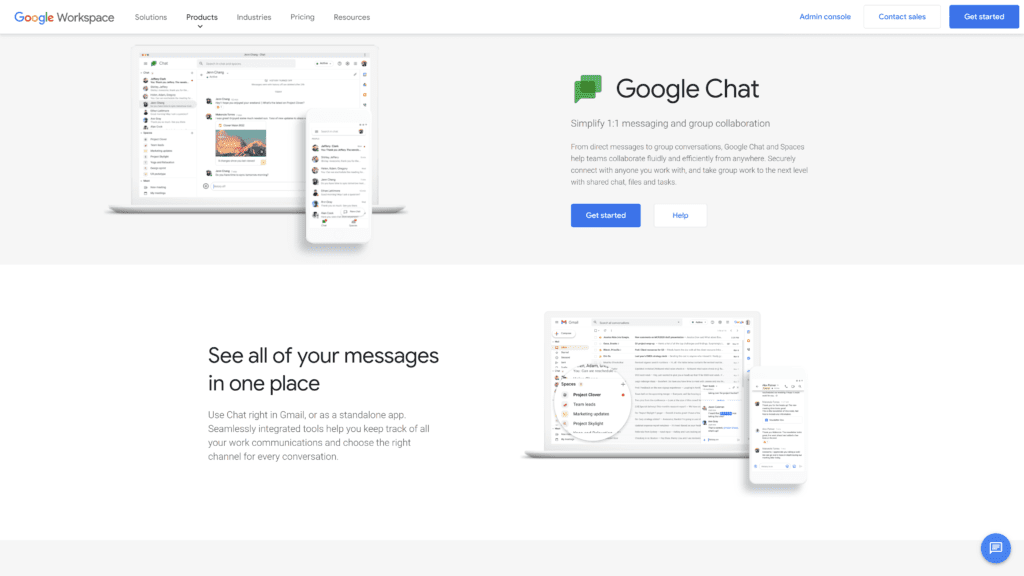
Google created Chat as part of its Workspace suite.
The platform allows users to participate in secure individual or group conversations.
You can even share files and tasks to improve workflow and team productivity.
It’s easy to click on a contact and open a conversation live or when it’s convenient.
Why Is This a Great Option?
Google Chat is an excellent choice for teams already paying for Google Workspace or using Gmail.
This platform is fast and effective with instant chats on desktops, laptops, and mobile devices.
It’s free for all Workspace teams and integrates with all Google products.
Plus, Google Chat offers the same security levels as the other products.
Drawbacks to Google Chat
The main drawback to choosing Google Chat is that it’s only free if you already use Workspace.
While it does support some third-party applications, Google doesn’t provide support for any issues you might encounter with them.
Additionally, the notification features need improvement to compete with the other options.
2. Fleep
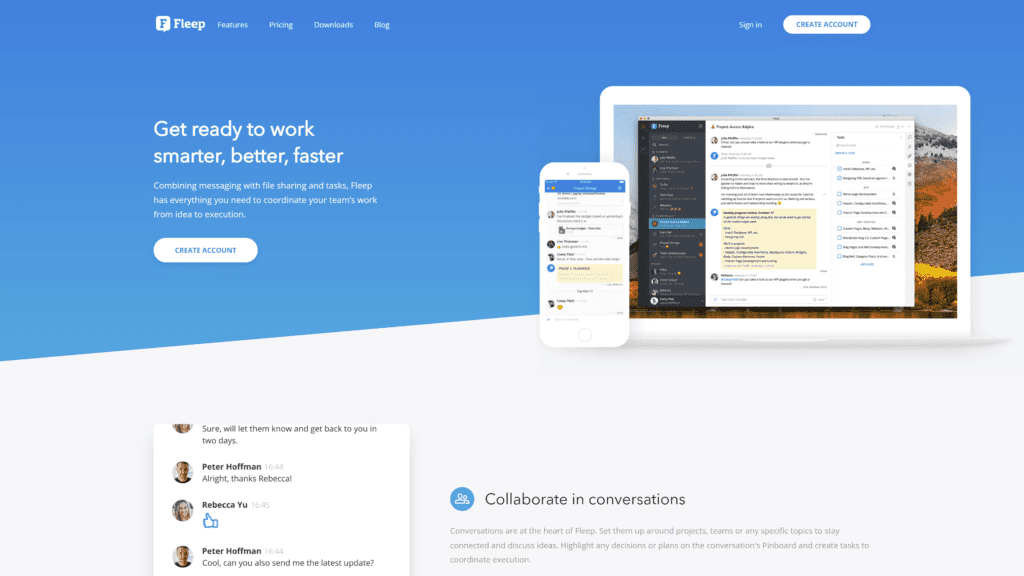
Fleep is another free Slack alternative that brings teams together with an intuitive interface.
It’s a basic, no-frills system that allows a team to communicate from different locations.
The interface is extremely easy to navigate thanks to the simple design with everything accessible from the main screen.
There’s no concern about losing your place or missing out on anything.
Why Is This a Great Option?
Fleep is incredibly simple and may be the most user-friendly option on the list.
The free version allows unlimited one-on-one conversations and one overarching group board.
If you appreciate Slack for its communication capabilities but not the price, Fleep is a viable alternative at a much lower cost.
Drawbacks to Fleep
Fleep doesn’t have enough power for larger companies and teams unless you pay to upgrade.
The free version lacks some key features, like unlimited group conversations, creating teams, and status messages.
While there’s no limit to individual chats, if you need a conversation with more than two members, you will need to upgrade.
Notable Mentions: Other Alternatives to Slack
Digging deeper into the world of communication platforms, here are a few more Slack alternatives.
4. Bitrix24
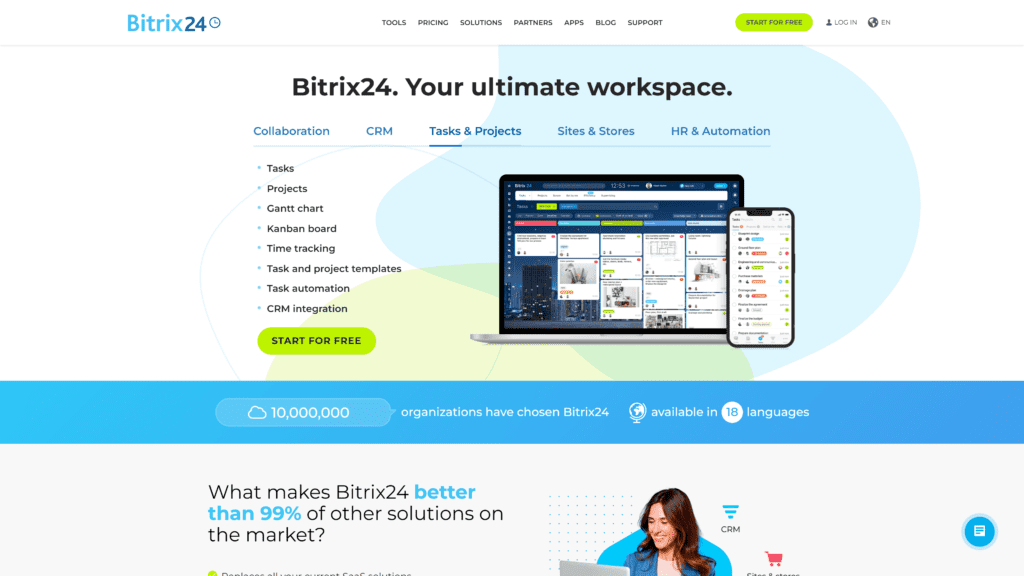
Bitrix24 is a workspace that aims to bring everything you need under one platform, including communication options.
Users can access a range of features, including video and audio conferencing, messaging, and online meetings.
The platform also offers customer relationship management (CRM) features with a contact center so that teams can communicate with clients.
Why Is This a Great Option?
Bitrix24 is a powerful, comprehensive option that can help organizations streamline workflow, sales funnels, communications, and human resources tasks.
It’s easy to use with options for restructuring teams and tracking various projects.
You can watch customer interactions. build a website, handle time tracking, and set up an online store.
Drawbacks to Bitrix24
Bitrix24 sounds like it has everything you need, but some things fall short.
First, the basic package starts at $61 per month for up to five users, and there are only two more tiers, 50 and 100 users.
There is a free option, but it has limited features.
The other notable concern is the lackluster customer service.
5. RingCentral Glip
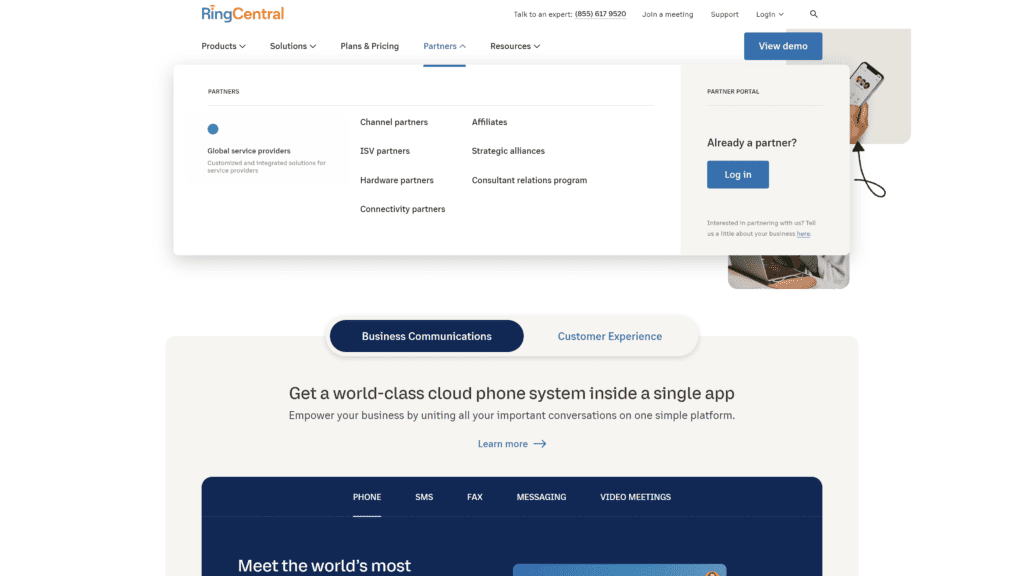
RingCentral Glip integrates team messaging systems with audio and video conferencing.
Teams can even host webinars through the secure, reliable RingCentral platform.
Like other platforms, teams can chat individually or in groups, share files, and seamlessly shift between chats and calls.
The chat features include emojis and other personalization options.
Why Is This a Great Option?
The video meeting capabilities mark Glip’s best features.
You get a 24-hour time limit for up to 100 users at a time.
You can also record videos for later viewing.
Attendees don’t have to download software because they can access it directly through a web browser.
It’s also possible to shift from desktop to mobile device for on-the-go attendance.
Drawbacks to RingCentral Glip
The main issue with RingCentral Glip is how complex it is in comparison to the alternatives.
Even the website feels busy and distracting.
Despite claiming to help teams organize, it lacks some key functions, like threaded conversations and notification settings.
It also doesn’t work well with some key platforms, like Microsoft Outlook.
6. Zulip
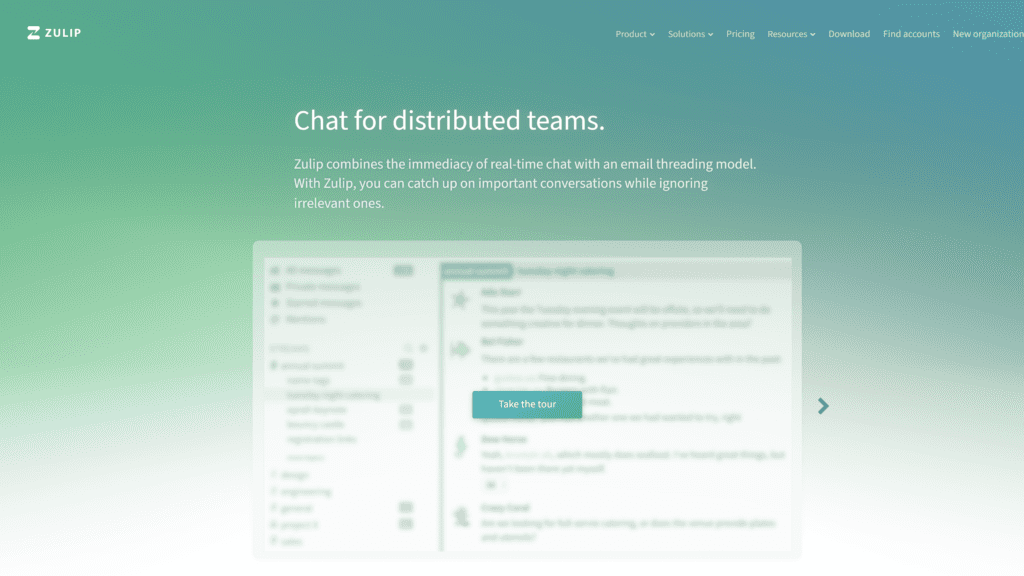
Zulip is an open-source communication platform with a range of features to improve collaboration and workflow abilities.
From in-app messaging to video calls, it’s easy to reach anyone in an organization at any point.
Users have multiple customizable options, including user role configurations and profiles.
Organizations can even add their branding to the apps.
Why Is This a Great Option?
Zulip offers some unique features that could give teams more control over their communications.
It’s possible to invite guests to certain groups without allowing access to all streams.
It’s possible to create and resolve topics, add permanent links, and sort conversations in Zulip.
Managers have access to team statistics, and there are several pricing options.
Drawbacks to Zulip
Zulip suffers from one of the common drawbacks of open-source software.
While it’s not impossible to figure out, the interface isn’t as intuitive as other options.
Additionally, the notifications are not functional, especially on mobile devices.
The other notable issue is that it’s not easy to find a viable hosting option for this platform.
Even More Options To Check Out
If you’re still looking for the perfect Slack alternative, we have three more possibilities for your consideration.
7. Ryver
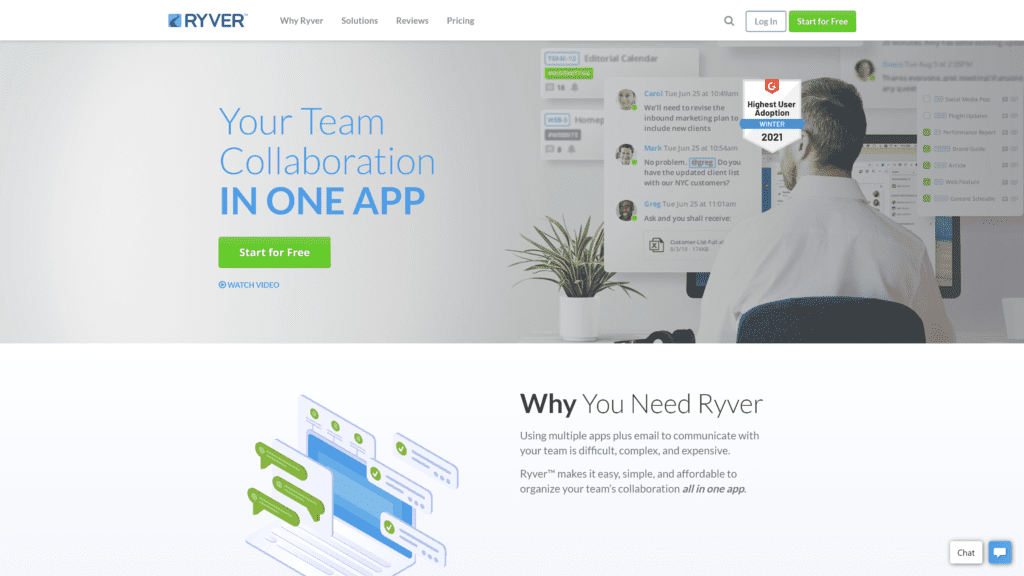
Ryver aims to streamline organizational communications with forums, team chats, and individual messaging options.
Users can create tasks to manage project completion and create new streams.
You can access a 14-day free trial with a package purchase.
Pricing starts at $69 per month for up to 12 users.
The platform has audio and video capabilities, but both options are currently in the beta phase.
You can currently integrate with some third-party apps, but only with Zapier.
Ryver is a little rough around the edges and tends to glitch if you click something by mistake.
Additionally, the interface looks cluttered when you have multiple people on a thread.
Following the larger group chats are nearly impossible because you can’t always tell who responds.
8. Twist
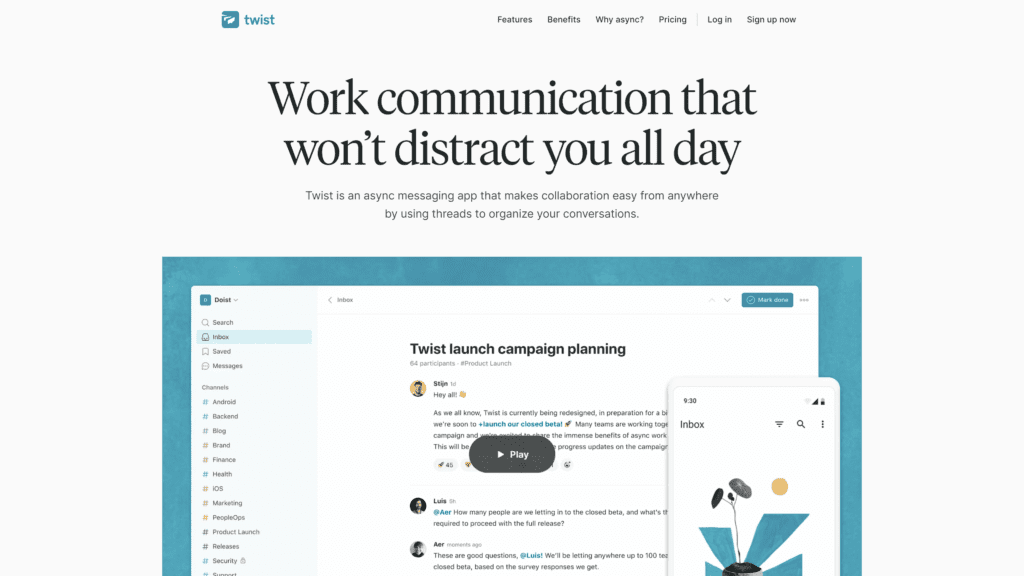
Twist keeps things simple with asynchronous communication channels that let team members access the information when they have time.
The platform aims to silence the endless notifications that distract people from their work without worrying about missing critical information.
Users can organize chats in several ways so that they don’t lose track of key things.
It’s still possible to carry out one-on-one conversations, use gifs and emojis, and break into small groups.
Twist also integrates with several third-party applications, including Asana and Google.
Twist isn’t ideal for people who need access to live chat, audio, or video conferencing.
For many teams, it’s not much of an upgrade over email, especially since the mobile version leaves a lot to be desired.
9. RocketChat
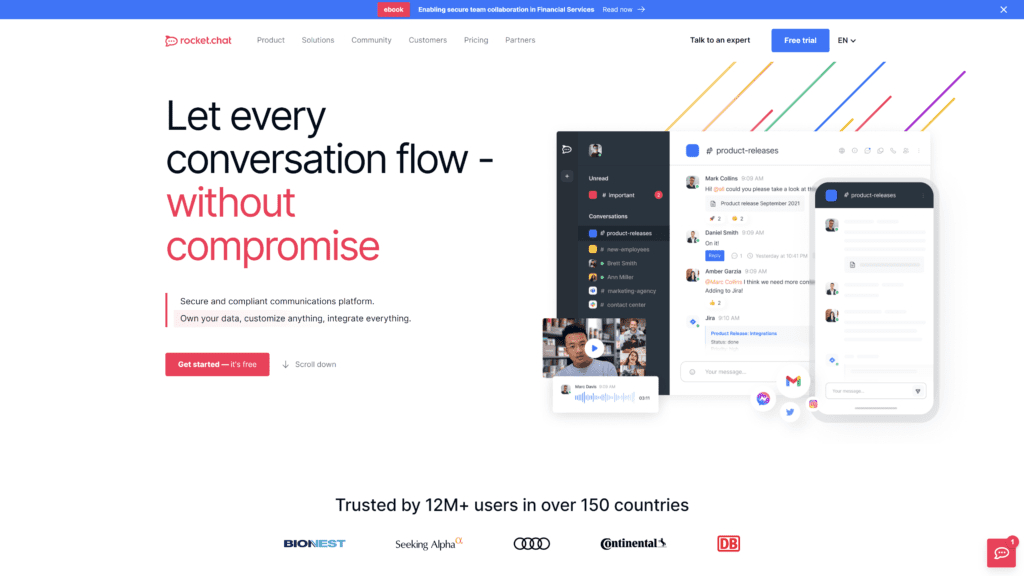
RocketChat claims to be a collaboration tool for teams of all sizes and shapes.
The platform boasts that people all over the world use it to improve employee and customer interactions.
Teams can handle projects from one place with the messaging system and task management tools.
Plus, it integrates with several third-party applications, including HubSpot, Zoom, Google, and Salesforce.
Unfortunately, RocketChat has significant issues with its interface. It feels clunky and confusing, especially with the installation process.
Other Alternative Roundups (Similar to Slack)
We need more than communication platforms to handle day-to-day tasks.
That’s where social media support, customer management systems, tools for blogging, and marketing platforms come into play.
If you’re looking for some help on those fronts, check out these roundups to see if there are any additional programs your business might be able to use.
- Asana Alternatives: Organization and task management take center stage with Asana, but it’s not the only platform that can keep your team on track.
- Mailchimp Alternatives: Email is a powerful marketing tool when used effectively, and Mailchimp is one of the most familiar names in the industry. It’s not the only option, and may not be your best choice, especially for large email campaigns.
- Todoist Alternatives: Listmakers might love Todoist and how it can streamline the task management process, but other platforms offer similar services. Check out this guide to determine which one is right for your team.
Frequently Asked Questions
Here are some of the most common questions and answers about Slack that can help you determine whether it’s the best communication platform for your team.
Is Slack still the best?
While Slack might be the best option for some teams, it may not deliver all of the tools and support other organizations require.
For teams that primarily need a communication tool, it’s a viable option.
However, if you need more task management or productivity support, there could be better solutions.
Is Slack really useful?
Slack is one of the top communication platforms for organizations.
It can be useful if you use it properly, especially when teams leverage the notification and group settings.
Plus, it’s easy to learn, and you can communicate through chat in real time or when it works for you.
Wrapping Up
Slack is a popular communication tool, but it can be expensive for a chat tool.
Small to medium organizations can benefit from other products that cater to their needs and deliver additional features.
Our favorite option is Microsoft Teams because it’s a powerful platform that lets teams connect in various ways.
Chat in real-time or message a coworker when it’s convenient for you, making it ideal for teams in different time zones.
If your team needs a free platform, it’s not easy to beat Google Chat, especially if you already use other Google tools.
Gmail users can even start chats from their email contacts, making it an easy transition when the email isn’t cutting it.
Hopefully, this guide helped you select a communication tool to bring your teams closer and improve productivity.
Let us know which ones you like best and any products we might have missed!

